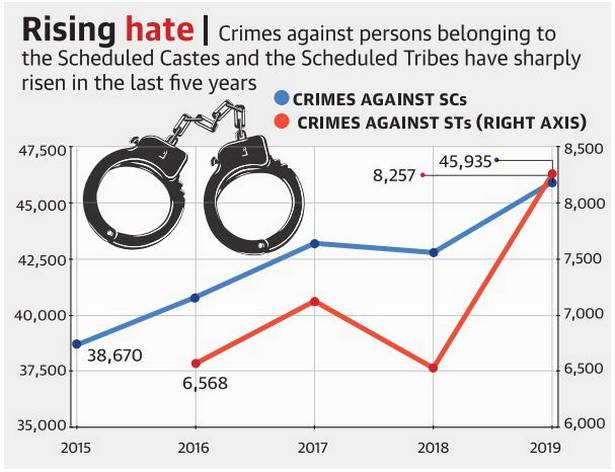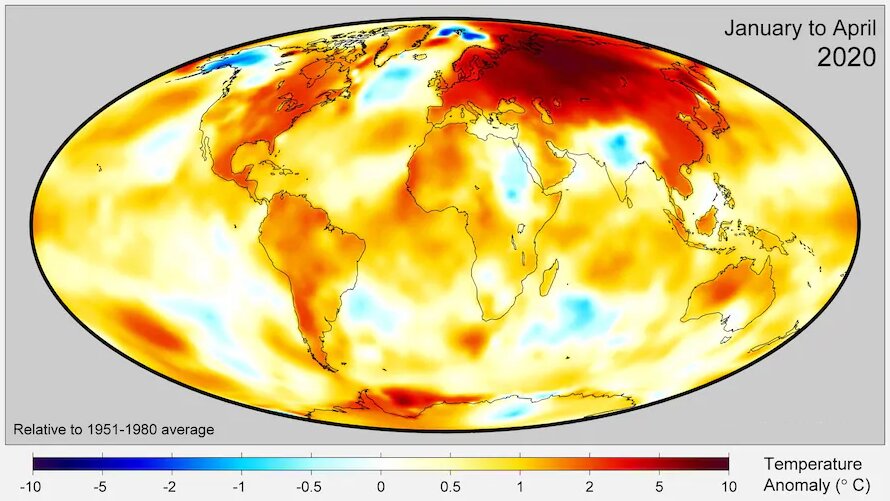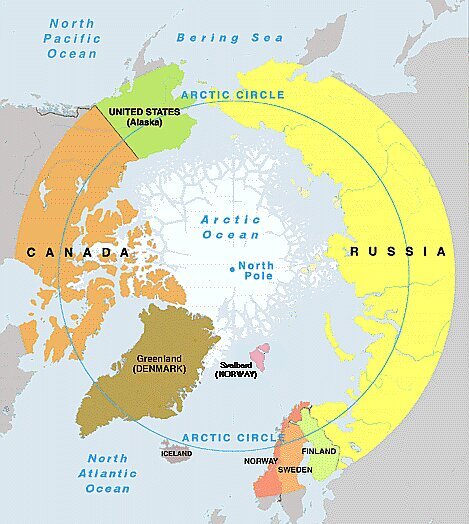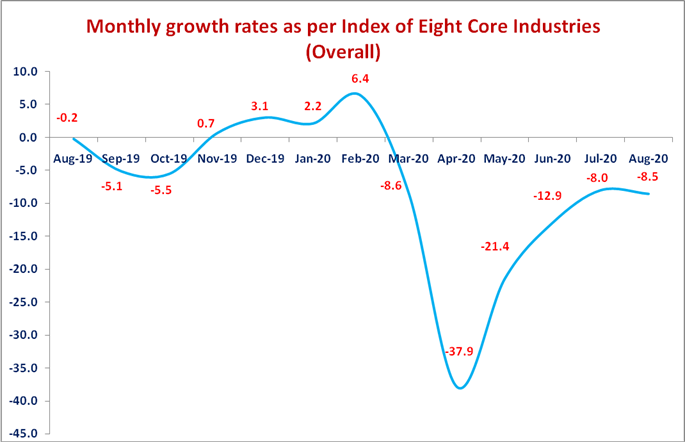Internal Security
Crime in India 2019 Report: NCRB
Why in News
The National Crime Records Bureau (NCRB) has released the annual Crime in India 2019 report.
- It reports an increase in crimes against Scheduled Castes (SCs) and Scheduled Tribes (STs) in the year 2019 as compared to the year 2018.
Key Points
- Crimes against SCs and STs:
- Crime against SCs have increased by over 7% and crimes against STs have increased by 26% in year 2019 compared to 2018.
- Uttar Pradesh recorded the highest number of crimes against SCs in 2019, followed by Rajasthan and Bihar.
- Madhya Pradesh recorded the highest number of cases against STs, followed by Rajasthan, and Odisha.
- Categories: Crimes against SCs and STs include the following categories:
- Atrocities committed by non-SC/ST members under the Scheduled Castes and Scheduled Tribes (Prevention of Atrocities Act), 1989 (POA Act)
- Indian Penal Code
- Protection of Civil Rights Act, 1955 : It prescribes punishment for the preaching and practice of Untouchability.
- Lack of Data
- According to the Commonwealth Human Rights Initiative (CHRI), very few cases were being registered for specific discriminatory action against SCs and STs under the POA Act.
- Such actions are registered mainly when accompanied by any of the IPC offences liek rape, murders etc.
- Also, there is no data on total complaints received on crimes against the Scheduled Castes, the only data available is the number of cases registered.
- Data on Other Crimes
- Cognizable Crimes: An increase of 1.6% in registration of cognizable crimes in 2019 as compared to 2018 was recorded. Cognizable crimes comprise Indian Penal Code (IPC) ones and Special and Local Laws (SLL) crimes.
- Cognisable offence means an offence in which a police officer has the authority to make an arrest without a warrant.
- SLL are Acts that are framed by the state government for specific issues.
- Crimes Against Women: Crime against women showed an increase of 7.3% in 2019 from 2018.
- 88 cases of crimes against women were recorded per day.
- Majority of cases under crime against women under IPC were registered under cruelty by husband or his relatives (30.9%), followed by assault on women with intent to outrage her modesty, kidnapping & abduction of women and rape .
- In the number of cases of rape of women belonging to SCs, Rajasthan topped the list, followed by Uttar Pradesh and Madhya Pradesh.
- Cybercrimes: Increased by 63.5% in 2019.
- 60.4% of cybercrime cases registered were for the motive of fraud followed by sexual exploitation.
- Cognizable Crimes: An increase of 1.6% in registration of cognizable crimes in 2019 as compared to 2018 was recorded. Cognizable crimes comprise Indian Penal Code (IPC) ones and Special and Local Laws (SLL) crimes.
- Other Related News: The Supreme Court recently upheld the constitutional validity of the Scheduled Castes and the Scheduled Tribes (Prevention of Atrocities) Amendment Act, 2018.
- The amendment act was challenged on the grounds of violation of the fundamental right to equality (Article 14) and personal liberty (Article 21).
- The amendment act adds article 18A which states that the preliminary enquiry shall not be required for registration of a First Information Report against any person.
- It also delineates specific crimes against Scheduled Castes and Scheduled Tribes as atrocities and describes strategies and prescribes punishments to counter these acts.
National Crime Record Bureau
- NCRB, headquartered in New Delhi, was set-up in 1986 under the Ministry of Home Affairs to function as a repository of information on crime and criminals so as to assist the investigators in linking crime to the perpetrators.
- It was set up based on the recommendations of the National Police Commission (1977-1981) and the MHA’s Task Force (1985).
- NCRB brings out the annual comprehensive statistics of crime across the country (‘Crime in India’ report).
- Being published since 1953, the report serves as a crucial tool in understanding the law and order situation across the country.
Biodiversity & Environment
Zombie Fire
Why in News
According to a new study, the fire regimes in the Arctic are changing rapidly, with ‘zombie fires’ becoming more frequent in addition to fires occurring in the once-frozen tundra.
Key Points
- Features:
- Zombie Fire: It is a fire from a previous growing season that can smoulder under the ground which is made up of carbon-rich peat. When the weather warms, the fire can reignite. These are also known as holdover fires.
- The fires in the Arctic spreading to areas which were formerly fire-resistant is a more worrying feature.
- The tundra is drying up and vegetation there like moss, grass, dwarf shrubs, etc are starting to catch fire.
- The tundra is a cold region of treeless level or rolling ground found mostly north of the Arctic Circle or above the timberline on mountains.
- In 2019 and 2020, burning occurred well above the Arctic Circle, a region not normally known to support large wildfires. Wildfires on permafrost in Siberia south of the Arctic are not uncommon.
- Reasons: The reason for this anomaly is that temperatures in winter and spring were warmer than usual during 2019-20.
- Temperature in Siberia in 2020 had gone through the roof, with the region recording a severe heatwave.
- Nearly all of this year’s fires inside the Arctic Circle occurred on continuous permafrost, with over half of these burning on ancient carbon-rich peat soils.
- Impact:
- The fires and record temperatures had the potential of turning the carbon sink into a carbon source and increasing global warming.
- The Arctic region has a cold body of water and permafrost, it naturally acts as a carbon sink. On average it absorbs 58 megatons of CO2 a year in its cold water.
- Soils in areas of permafrost contain twice as much carbon as there is currently in the atmosphere.
- As the climate and permafrost soils have warmed, microbes have started to break down this organic carbon, which has been frozen and fixed in the permafrost. That has led to a rise in land emissions of CO2 and methane.
- Also there will be less absorption of carbon by water with rising temperature.
- It will be a feedback loop: As peatlands release more carbon, global warming increases, which thaws more peat and causes more wildfires.
- Arctic fires will affect the global climate over the long term depending on what they burnt. That’s because peatlands, unlike boreal forest, do not regrow quickly after a fire, so the carbon released is permanently lost to the atmosphere.
- The fires and record temperatures had the potential of turning the carbon sink into a carbon source and increasing global warming.
Arctic Region
- The Arctic region, or the Arctic, is a geographic region spreading around the North Pole.
- The Arctic Circle (66° 33'N) delimits the Arctic in terms of solar radiation.
- Based on temperature, the monthly average temperature in the Arctic is below + 10°C throughout the year, even in summer.
- The Arctic contains vast stores of carbon and other planet-warming greenhouse gases in its soils, in peat as well as frozen soil that can be freed up through combustion.
- Peatlands are wetlands that contain ancient, decomposed and partially decomposed organic matter.
- Nearly half the world’s peatland-stored carbon lies between 60 and 70 degrees north, along the Arctic Circle.
- Arctic Permafrost: It is ground that remains completely frozen at 0 degrees Celsius or below for at least two years and is defined solely based on temperature and duration.
- It is composed of rock, sediments, sand, dead plant and animal matter, soil, and varying degrees of ice and is believed to have formed during glacial periods dating several millennia.
- It is mainly found near the polar zones and regions with high mountains covering parts of Greenland, Alaska, Russia, Northern Canada, Siberia and Scandinavia.
- Permafrost is the most threatened by climate change, Arctic regions are warming twice as fast compared to the rest of the planet, its current rate of temperature change being the highest in 2,000 years.
Way Forward
- There is an urgent need to understand the nature of fires in the Arctic which are evolving and changing rapidly.
- This study has urged global cooperation, investment and action in monitoring fires. It has called for learning from the indigenous peoples of the Arctic about how fire was traditionally used.
- New permafrost- and peat-sensitive approaches to wildland firefighting are needed to save the Arctic.
Indian Economy
Contraction in August Core Industry Output: IIP
Why in News
India’s eight core industrial sectors contracted by 8.5% in August 2020 compared to August 2019, marking the sixth month in a row of shrinking output.
- The eight core sector industries are coal, crude oil, natural gas, refinery products, fertilisers, steel, cement and electricity.
- These eight industries account for 40.27% in the Index of Industrial Production (IIP).
Key Points
- Contraction:
- The cumulative growth of Core Industries during April to August, 2020-21 has been (-) 17.8%.
- Except for coal and fertilisers, production continued to decline in most core sectors in August.
- Coal production increased 3.6% on-year in August after four months of contraction, due to improvement in offtake level.
- An offtake agreement is an arrangement between a producer and a buyer to purchase or sell portions of the producer's upcoming goods.
- Coal production increased 3.6% on-year in August after four months of contraction, due to improvement in offtake level.
- The steepest decline in August was observed in refinery products, which dropped 19.1%. This was followed by cement, and natural gas.
- Reason: The drop in August is due to factors like:
- Low demand in the economy.
- Unavailability of equipment for setting up newer production platforms.
- Seasonal and lockdown restrictions.
Index of Industrial Production
- The Index of Industrial Production (IIP) is an index that shows the growth rates in different industry groups of the economy in a fixed period of time.
- It is compiled and published monthly by the National Statistical Office (NSO), Ministry of Statistics and Programme Implementation.
- IIP is a composite indicator that measures the growth rate of industry groups classified under:
- Broad sectors, namely, Mining, Manufacturing, and Electricity.
- Use-based sectors, namely Basic Goods, Capital Goods, and Intermediate Goods.
- The eight core sector industries represent about 40% of the weight of items that are included in the IIP.
- The eight core industries in decreasing order of their weightage: Refinery Products (28.04 %)> Electricity (19.85 %)> Steel (17.92 %) > Coal (10.33 %)> Crude Oil (8.98 %)> Natural Gas (6.88 %)> Cement (5.37 %)> Fertilizers (2.63 %).
- Base Year for IIP calculation is 2011-2012.
- Significance of IIP:
- IIP is the measure on the physical volume of production.
- It is used by government agencies including the Ministry of Finance, the Reserve Bank of India, etc, for policy-making purposes.
- IIP remains extremely relevant for the calculation of the quarterly and advance Gross Domestic Product (GDP) estimates.
Social Justice
International Day of Older Persons
Why in News
The International Day of Older Persons (IDOP) is observed on 1st October (designated in 1990 by the United Nations General Assembly) every year.
Key Points
- The 2020 theme aims to:
- Promote Decade of Healthy Ageing (2020-2030).
- The Decade of Healthy Ageing has been endorsed by the 73rd World Health Assembly (decision making body of the World Health Organisation) in 2020.
- It is an opportunity to bring together governments, civil society, international agencies, professionals, the media, and the private sector for ten years of concerted, catalytic and collaborative action to improve the lives of older people, their families, and the communities in which they live.
- Healthy Ageing is the process of developing and maintaining the functional ability that enables wellbeing in older age. Functional ability is about having the capabilities that enable all people to be and do what they have reason to value.
- Reduce the health disparities between older persons in the developed and developing countries, so as to “Leave no one behind”.
- Appreciate the role of the health care workforce in maintaining and improving the health of older persons, with special attention to the nursing profession.
- The year 2020 has also been recognised as the “Year of the Nurse and Midwife”.
- Increase understanding of the impact of Covid-19 on older persons.
- Promote Decade of Healthy Ageing (2020-2030).
- Related Data:
- By 2020, the number of people aged 60 years and older will outnumber children younger than 5 years.
- Over the next three decades, the number of older persons worldwide is projected to more than double, reaching more than 1.5 billion persons in 2050, and 80% of them will be living in low- and middle-income countries.
- The Covid-19 pandemic may significantly lower older persons’ incomes and living standards. Already, less than 20% of older persons of retirement age receive a pension.
- India Specific Data:
- As per Census 2011, the total population of Senior Citizens (people aged 60 years and above) is 10.38 crore, of which the population of males and females are 5.11 crore and 5.27 crore respectively.
- The share of senior citizens in the total population as per Census 2011 is 8.57%. As per the May 2006 Report of the “Technical Group on Population Projections” constituted by the National Commission on Population published by the Office of the Registrar General of India this share is expected to increase to 10.70% in 2021 and to 12.40% in 2026.
- Initiatives Taken by India:
- The Ministry of Social Justice and Empowerment is the Nodal Ministry for matters relating to the Senior Citizens.
- Article 41 of the Constitution states that the State shall, within the limits of its economic capacity and development, make effective provision for securing the right to work, to education and to public assistance in cases of unemployment, old age, sickness and disablement, and in other cases of undeserved want.
- Integrated Programme for Older Persons: It is a central sector scheme. Financial assistance is provided to Government/ Non-Governmental Organizations/Panchayati Raj Institutions/local bodies etc. for running and maintenance of various projects for the welfare of indigent Senior Citizens.
- Pradhan Mantri Vaya Vandana Yojana: It is a pension scheme for senior citizens that comes with guaranteed returns on monthly, quarterly, half-yearly or on an annual basis for a period of 10 years. It is exclusively available to those who are 60 years of age and above.
- Maintenance and Welfare of Parents and Senior Citizens (MWPSC) Act, 2007: To ensure need-based maintenance for Parents and Senior Citizens and their welfare.
- Vayoshreshtha Samman: Conferred as a National award (part of celebrations of International Day of Older Persons), and given to eminent senior citizens & institutions in recognition of their services towards the cause of the elderly persons.
Important Facts For Prelims
Ambedkar Social Innovation and Incubation Mission
Why in News
The Ministry of Social Justice & Empowerment has launched the ‘Ambedkar Social Innovation and Incubation Mission (ASIIM)’ under Venture Capital Fund for Scheduled Castes (SCs) with a view to promoting innovation and enterprise among SC students studying in higher educational institutions.
Key Points
- Major Objectives of the Mission:
- To promote entrepreneurship among the SC Youth with special preference to Divyangs.
- To support (1,000) innovative ideas till 2024 through a synergetic work with the Technology Business Incubators (TBIs) set up by the Department of Science and Technology.
- Implemented By: Venture Capital Fund for SCs (VCF-SCs) which was set up in 2015-16 with the Fund size of Rs. 500 Crore. Under this fund, 117 companies promoted by SC entrepreneurs have been sanctioned financial assistance to set up business ventures.
- Features:
- 1,000 SC youth would be identified in the next 4 years with start-up ideas through the Technology Business Incubators (TBIs) in various higher educational institutions.
- They will be funded @ Rs. 30 lakhs in 3 years as equity (investment) funding so that they can translate their start-up ideas into commercial ventures.
- Successful ventures would further qualify for venture capital funding of up to Rs. 5 Crore from the VCF-SCs.
- Venture capital is a form of private equity and a type of financing that investors provide to startup companies and small businesses that are believed to have long-term growth potential.
- Eligibility:
- Youth who have been identified by the TBIs.
- Students who have been awarded under the Smart India Hackathon or Smart India Hardware Hackathon being conducted by the Ministry of Education.
- Innovative ideas focusing on the socio-economic development of the society identified in the TBIs.
- Start-ups nominated and supported by corporates through Corporate Social responsibility (CSR) funds.
- Significance:
- ASIIM under VCF-SC will promote innovation in the SC youth and would help them to become job-givers from job-seekers.
- It would further give fillip to the ‘Stand Up India’ initiative of the Prime Minister.
Internal Security
BrahMos Testing
Why in News
BrahMos Land-Attack Cruise Missile (surface-to-surface) was successfully flight tested from the Integrated Test Range at Balasore in Odisha.
Key Points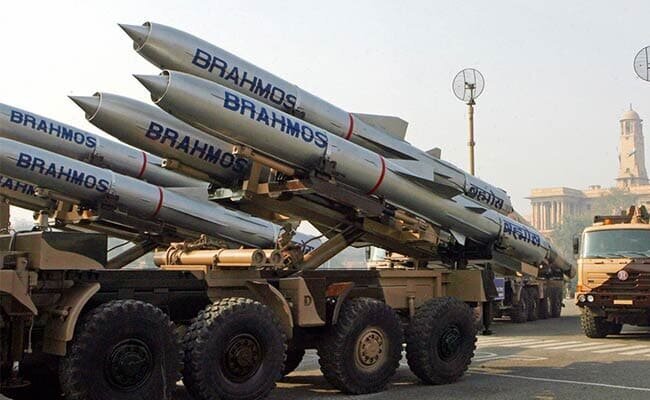
- It is a joint venture between the Defence Research and Development Organisation of India (DRDO) and the NPOM of Russia.
- Brahmos is named on the rivers Brahmaputra (India) and Moskva (Russia).
- It is a supersonic missile travelling at a speed of Mach 2.8 (nearly three times the speed of sound)
- It is the world’s fastest supersonic cruise missile.
- It is a multiplatform i.e it can be launched from land, air, and sea and multi capability missile with pinpoint accuracy that works in both day and night irrespective of the weather conditions.
- It is, therefore, used by all three forces, the Army, Navy and the Air Force.
- It operates on the "Fire and Forget" principle i.e it does not require further guidance after launch.
- It is the heaviest weapon to be deployed on Sukhoi-30 MKI fighter aircraft, with a weight of 2.5 tonnes.
- Its range has been recently enhanced from 300 Km to 450-600 Km,
- Increasing the missile’s range became possible after India’s induction into the Missile Technology Control Regime (MTCR) in June 2016.
- The missile features indigenous Booster and Airframe Section, along with many other indigenous sub-systems.
- Advantages:
- BrahMos has been deployed in Ladakh as well as the Eastern Sector in Arunachal Pradesh to tackle any threats in the ongoing standoff with China.
- Enhanced use of indigenous technologies will give a boost to India’s AtmaNirbhar Bharat and Make in India Initiatives.
- Increasing indigenous content in defence systems has also been a prime focus of Defence Acquisition Procedure, 2020 and draft Defence Production and Export Promotion Policy 2020.
- Others:
- India is also working on a hypersonic missile, BrahMos-II (K), capable of taking out hardened targets such as underground bunkers and weapon storage facilities at seven times the speed of sound (Mach 7).

